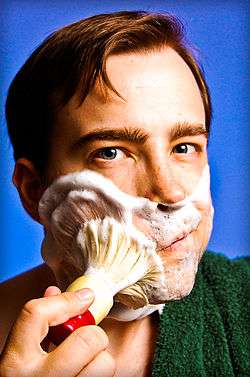Shaving cream

Shaving cream or shaving foam is a frothy cosmetic cream applied to body hair, usually facial hair, to facilitate shaving. The use of cream achieves three effects: lubricates the cutting process; swells keratin; and desensitizes skin. Shaving creams commonly consist of an emulsion of oils, soaps or surfactants, and water.[1] Blades with polymeric coating reduce the need for shaving creams.
History

A rudimentary form of shaving cream was documented in Sumer around 3000 BC. This substance combined wood alkali and animal fat and was applied to a beard as a shaving preparation.[2]
Until the early 20th century, bars or sticks of hard shaving soap were used. Later, tubes containing compounds of oils and soft soap were sold. Newer creams introduced in the 1940s (Burma-Shave) neither produced lather nor required brushes, often referred to as brushless creams.[3]
The first can of pressurized shaving cream was Rise shaving cream, introduced in 1949.[4] By the following decade this format attained two-thirds of the American market.[5] Chlorofluorocarbons (CFCs) were used as propellants until they were banned in the late 1970s for destroying the ozone layer.[6] Gaseous hydrocarbons such as mixtures of pentane, propane, butane and isobutane took their place.[7]
In the 1970s, shaving gel was developed.[8] In 1993, The Procter & Gamble Company patented a post-foaming gel composition, which turns the gel into a foam after application to the skin, combining properties of both foams and gels.[9]
Contents
Shaving creams and soaps are available as solids (bars); creams, generally in tubes; or aerosols. All forms may be applied with a shaving brush.
Shaving creams contain 20–30% soap [potassium or triethanolamine (TEA)], up to about 10% glycerine, emollients, emulsifiers, and foaming agents. Aerosols are diluted creams dispensed from pressurized cans with the aid of hydrocarbon propellants (up to about 10%).[10] The flammability of the hydrocarbons is offset by the large amounts of water in cream formulations.[11]
Beard-softening is due to hair hydration, which also depends on pH. In electric or dry shaving, swelling of the hairs is not desired, and such preparations use high amounts of alcohol (50–80%) to dry the skin and stiffen the hairs.
See also
| Wikimedia Commons has media related to shaving cream. |
References
- ↑ Thomas Clausen et al. "Hair Preparations," Ullmann’s Encyclopedia of Industrial Chemistry. Wiley-VCH, Weinheim (2006). doi:10.1002/14356007.a12_571.pub2
- ↑ "History of Shaving" at Gillette Archived 10 June 2016 at the Wayback Machine.
- ↑ Butler, Hilda; Poucher, William Arthur (2000). Poucher's perfumes, cosmetics and soaps. Springer. p. 51. ISBN 978-0-7514-0479-1.
- ↑ "1949: Carter launches Rise, the first pressurized shave cream". Funding Universe.
- ↑ Butler, Hilda; Poucher, William Arthur (2000). Poucher's perfumes, cosmetics and soaps. Springer. p. 51. ISBN 978-0-7514-0479-1.
- ↑ "A Look at EPA Accomplishments: 25 Years of Protecting Public Health and the Environment". United States Environmental Protection Agency. 1 December 1995. Retrieved 22 November 2008.
- ↑ "Cost and Emission Reduction Analysis of HFC Emissions from Aerosols in the United States" (pdf). United States Environmental Protection Agency. June 2001. Retrieved 22 November 2008.
- ↑ "Canadian Patent #2027218". Canadian Patents Database. Canadian Intellectual Property Office. Retrieved 22 November 2008.
- ↑ U.S. Patent 5248495, issued 28 September 1993
- ↑ Martin M. Rieger (2013), "Cosmetics", in Arza Seidel; et al., Kirk-Othmer Chemical Technology of Cosmetics, pp. 36–37
- ↑ Gannes, Stuart; Slovak, Julianne (14 March 1988). "A DOWN-TO-EARTH JOB: SAVING THE SKY". Fortune. Retrieved 22 November 2008.